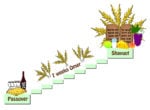
Five-Hundred-Year-Journey
Alexander Poltorak Abstract This essay addresses the anigmatic statement of the Jewish Sages, stating that G-d created this world with the letter Heh and the

Alexander Poltorak Abstract This essay addresses the anigmatic statement of the Jewish Sages, stating that G-d created this world with the letter Heh and the
And it came to pass, when he was come near to enter into Egypt, that he said unto Sarai his wife: “Behold now, I know
In the six hundredth year of Noah’s life, in the second month, on the seventeenth day of the month, on the same day were all

And G‑d created man in His own image, in the image of G‑d created He him; male and female created He them. And G‑d blessed

A light shalt thou make to the ark…with lower, second, and third stories shalt thou make it. (Genesis 6:16) We mentioned in the previous posts

There is a Biblical Commandment to count the days between the Passover and Shavuot, the “Feast of Weeks” (a.k.a. Pentecost). We start counting on the

Meditations on the Maaseh Merkavah – I We do science by studying nature. We study physics in a lab, peering into space or working out

When thou shalt besiege a city a long time, in making war against it to take it, thou shalt not destroy the trees thereof by
In the Torah portion Emor (Leviticus 21:1–24:23), we are instructed to abstain from work every seventh day on Shabbat. Next week’s Torah portion, Behar, continues